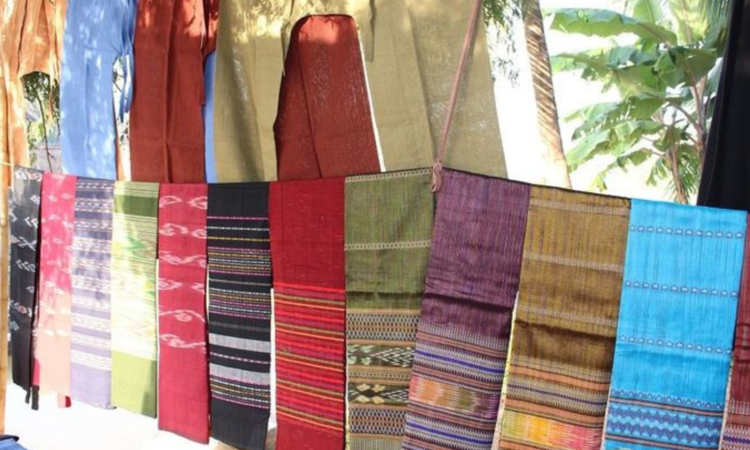What Makes Cambodian Traditional Clothing Special?
Even if you have never traveled to Cambodia, you probably are familiar with their beautiful silk and cotton exports. Explore the rich tradition of Cambodia’s textile industry, and take a look at some of the most important elements of Cambodian traditional attire
If you are planning to take a tour of Cambodia, you should know that Cambodian textile arts weave through the history, culture and economy of the country, knitting it all together. Cambodian garments unite past and present, tradition and innovation, beauty and utility.
Even if you have never traveled to Cambodia, you probably are familiar with their beautiful silk and cotton exports. In this post, we will explore the rich tradition of Cambodia’s textile industry, and take a look at some of the most important elements of Cambodian traditional attire. Our special focus will be on the Cambodian traditional clothing wrap called the sampot as well as the scarf known as the krama.
The Importance of Textiles in Cambodian Clothing
We can trace the history of silk and cotton weaving in Cambodia all the way back to the Khmer Empire. Traditional methods of weaving include “uneven twill” and “ikat,” called “chong kiet” in Khmer. Designs of spots, stars and lattices are among the most recognizable traditional patterns.
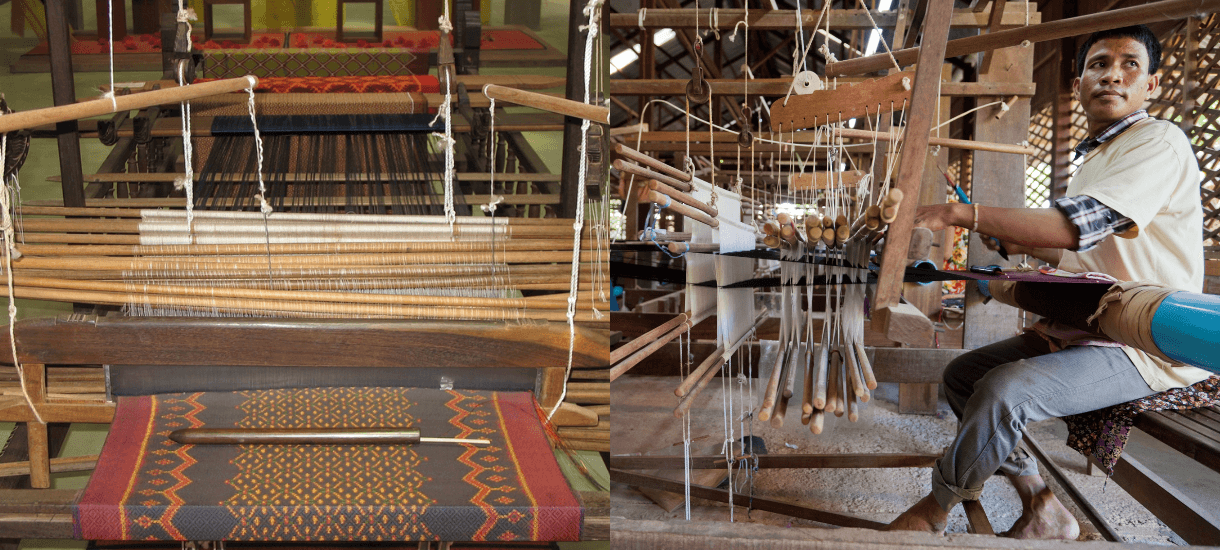
According to the BBC, Cambodian textile arts nearly perished when 90% of the artisan population was killed during the Khmer Rouge regime. This totalitarian government held an iron grip over the country from 1975 through 1979. Luckily, enough artisans survived to ensure that the tradition of Cambodian textiles would once again be able to flourish. Today, Cambodian textiles form a cornerstone of the country’s economy.

Cambodian fabrics and garments are so unique thanks to their distinguishing colors, patterns, and styles which can tell the social status of the wearer in Cambodian’s social hierarchy. Historical researchers have been able to trace some of the cultural trends and rules for attire across social classes through different epochs of Cambodia’s history.
Later on in this post, we will explain how the sampot helped to distinguish members of the nobility from commoners. But first, let’s explain what exactly a sampot is.
Sampot - Cambodian Traditional Dress
The sampot is a garment that is worn in Cambodia, Thailand and Laos. It is a simple garment, taking the form of a rectangular piece of silk.
At 3 meters in length and 1 meter in width, it is long enough that the wearer can drape it around the waist. Similar types of garments in other countries include the Burmese longyi, the Thai sarong, and the Indian dhoti and lungi. Actually, to some degree, the words sampot and sarong are used interchangeably.
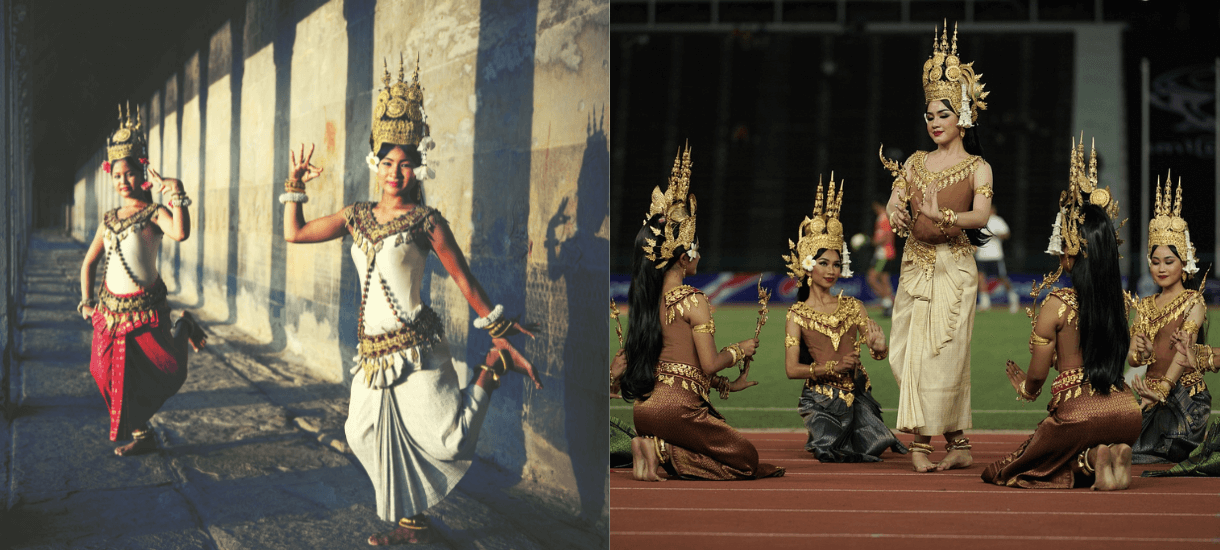
From the basic description, you might assume that a sampot is like a skirt. But the wearer usually uses a belt to hitch up the fabric between their legs. That way, the sampot functions similarly to trousers. When a shirt is worn with a sampot, it usually is a chang pong. This garment drapes over one shoulder.
During some periods of history (see below), the sampot was worn by the nobility, rather than by commoners. But today, men and women of different economic classes all wear the sampot. In fact, it has become a mainstay for lower-class Cambodians, who find it comfortable as they go about their workdays.
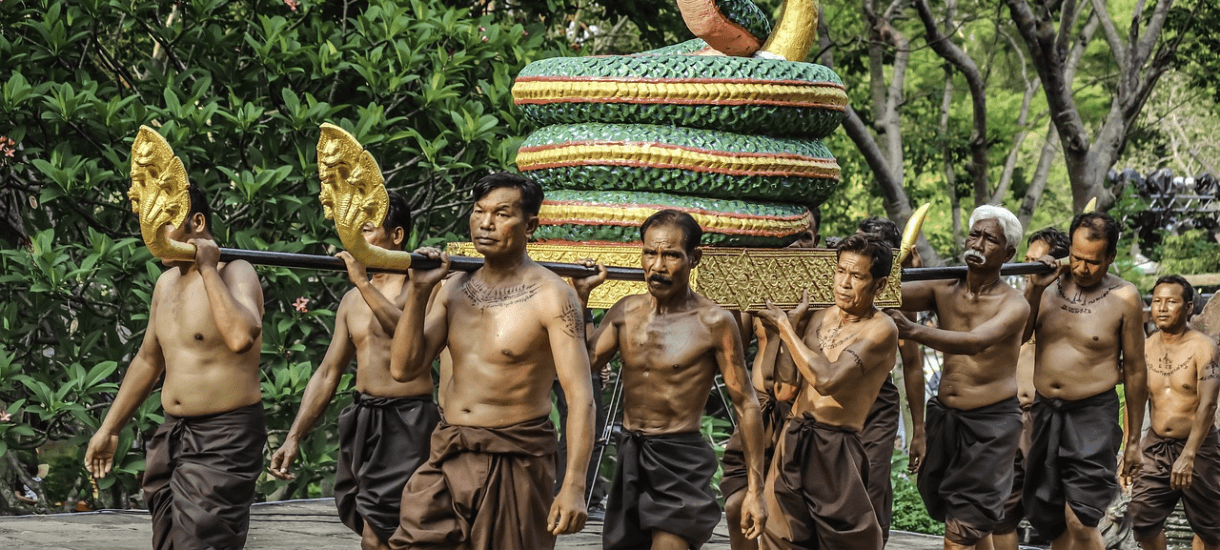
Sampot Through the Ages
During the Funan Era (68-550), the garment called the sampot Chong Kben was the usual attire for noblemen. Ladies during this era wore brocaded sarongs. Members of the lower classes during the Funan Era did not wear the sampot or sarongs; instead, they wore straw skirts. That meant that if you were to see someone wearing a sampot during this era, it would have marked them out as a member of the aristocracy.
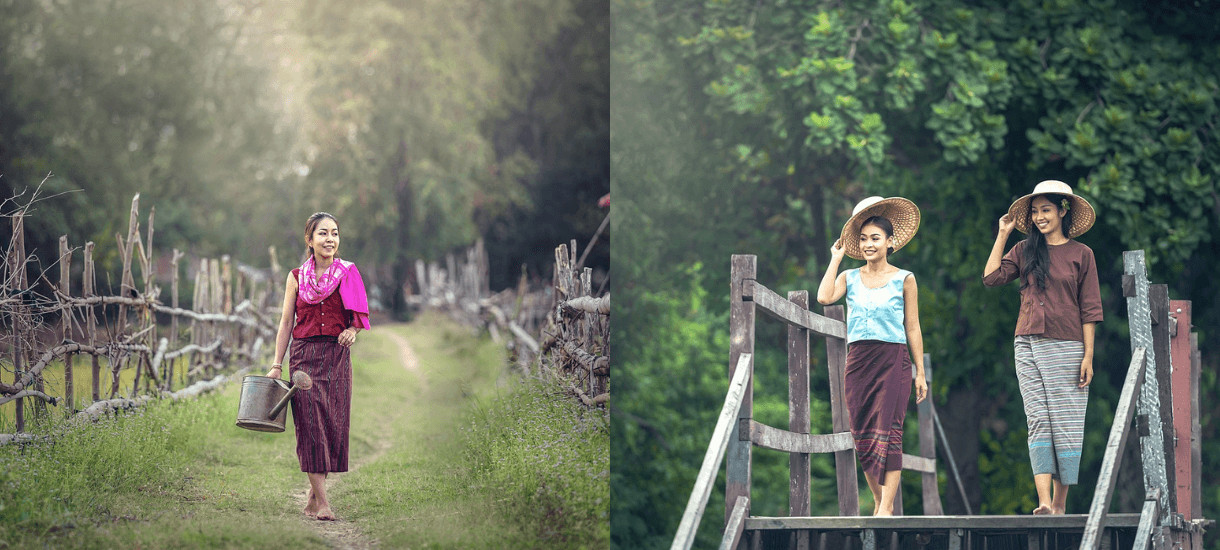
During the Chenla era, from 550 to 802, garments were not all that different from those popular in the Funan era, but the sampot evolved in new directions, and noble women added a band of beads called a sava.
Moving onto the Angkor Era from 802 to 1432, many of the rules surrounding attire had to do with the patterns on the fabric. The higher a person’s status, the more flowers could be on their clothing. Poor women were allowed exactly two flowers, while poor men were not allowed any flowers.
Up until this point, Cambodian sampot fashions typically involved going shirtless. But during the Charktomok period (1432—1525), that started to change The Chong Kben wrap was popular for men during this era, while Chong pok wraps were the popular fashion for women. A sign of wealth was the addition of a shawl, which poorer women could not afford. Wealthy men purchased shirts.
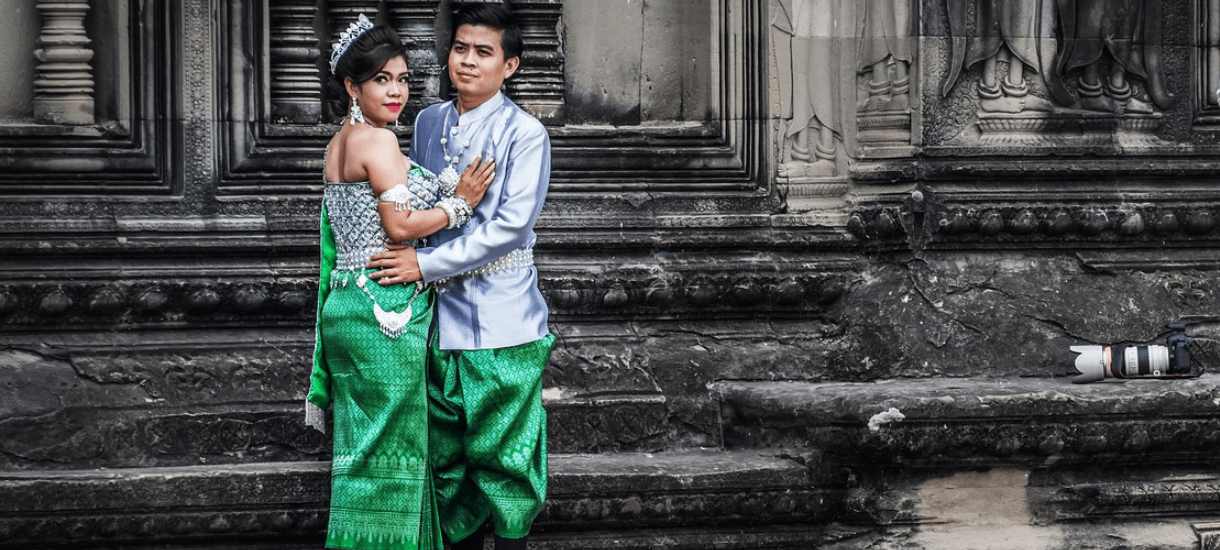
The reason that Cambodian traditional clothing moved away from the sampot toward wraps during the Charktomok era had to do with a shift from Hinduism toward Buddhism. This change had broad-sweeping ramifications for every aspect of Cambodian life, including fashion.
Through the eras that followed, European influences began mixing in with traditional Cambodian fashions.
During the Khmer Rouge regime during the 1970s, Cambodian men and women were forced to wear black pyjamas. The only bright colors were the krama scarves, checkered in red and white. Thankfully, when the oppressive Khmer Rouge regime came to an end, Cambodians could once again wear their traditional fashions, including the sampot.
Discover Different Sampot Fashions
While you are browsing sampot garments in Cambodian markets, you will notice that there are a few different kinds of sampot. Here is how to identify them.
Chong Kben: This garment measures 2.7 meters in length and 1 meter in width. It functions as pants, and is considered a formal garment suitable for events. After wrapping the Chong Kben sampot, the wearer uses a metal strap and a button in the front to secure it. It is also popular among members of the government.
Phamuong: Each individual sampot phamuong garment is twill woven with 22 needles using a special traditional technique and features a single dominant color (there can be patterns in another color). Exactly 52 different colors of Phamuong exist. While patterns can range, some common motifs include flowers, leaves, and geometric shapes.
Hol: Conventional and cross-woven hol sampot garments come in four different varieties: sampot hol, sampot hol kben, sampot hol por and sampot hol ktong. Colors available include red, blue, yellow, green and brown in combinations of three or five. More than 200 patterns are possible, usually featuring flowers, animals, or geometric shapes.
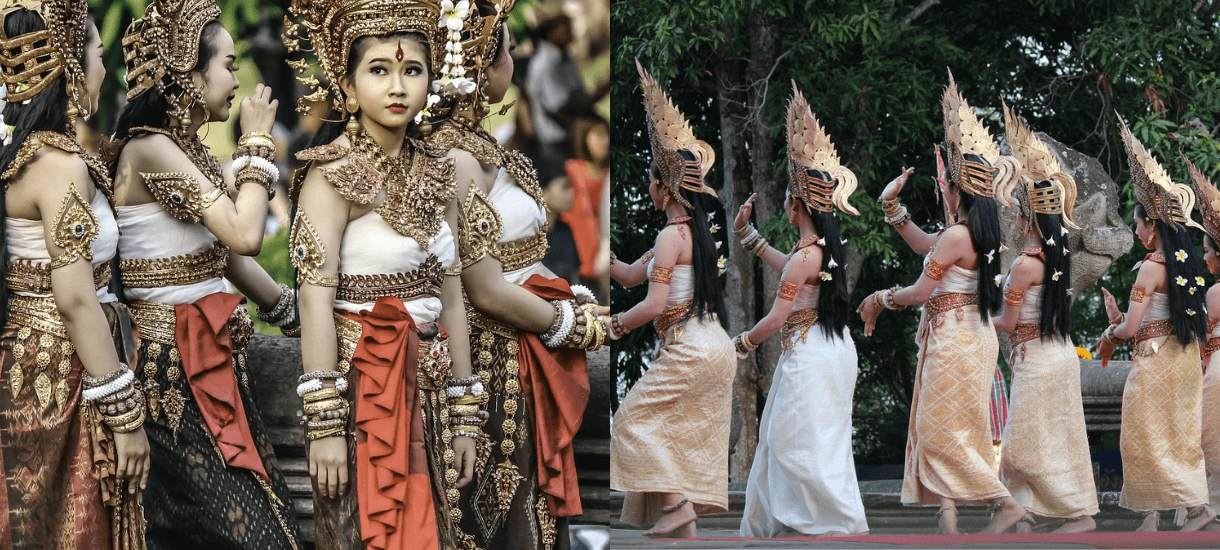
Krama - Multipurpose Clothing Accessories
Now you know about sampot. Let’s discover krama, another important item of Cambodian cultural clothing.
The krama is a textile accessory that is so ubiquitous in Cambodian society that it is now the national symbol. That said, it is believed that its origins are from beyond the country’s borders; the original krama scarves may have been brought over from India. These garments have been around since roughly 1-5 CE, weaving through eras and uniting the threads of history.

(Photo Credit: Cambodia Travel)
The most iconic krama is one with a checkered design in red and white or blue and white. But you will see krama with other colors and designs as well. Every group in society commonly wears the krama: young and old, male and female.
That said, the red and white krama is sometimes associated with the uniform that Cambodians were forced to wear during the Khmer Rouge regime. So, while some people are comfortable with it and choose to reclaim it from that era, others avoid it in that particular pattern and color combination. The decision is a very personal one.
What is Krama Made Of?
You will find krama made of various fabrics. Cotton and silk are common, but sometimes you will run into krama that are made of synthetic fabrics. Regardless of the material, krama is usually woven to be strong since they are subjected to a lot of daily use.
Different Ways Cambodians Wear Krama
The krama is an impressive multipurpose article of clothing. Here are some ways that Cambodians wear it:
Scarf: A krama can be worn loosely around the neck as a comfortable scarf, and can be tied in a number of different ways.
Bandana: Another of the most common ways to wear a krama is as a bandana or head covering. Once again, there are multiple ways to style the krama for this purpose, making it easy to create individual looks.
Face covering: Sometimes people may use the krama to cover their noses and mouths. Doing so may provide protection against dust or germs.
Embellishment: Since the krama is such a versatile accessory, it can be used to embellish other outfits with some extra color and flair.
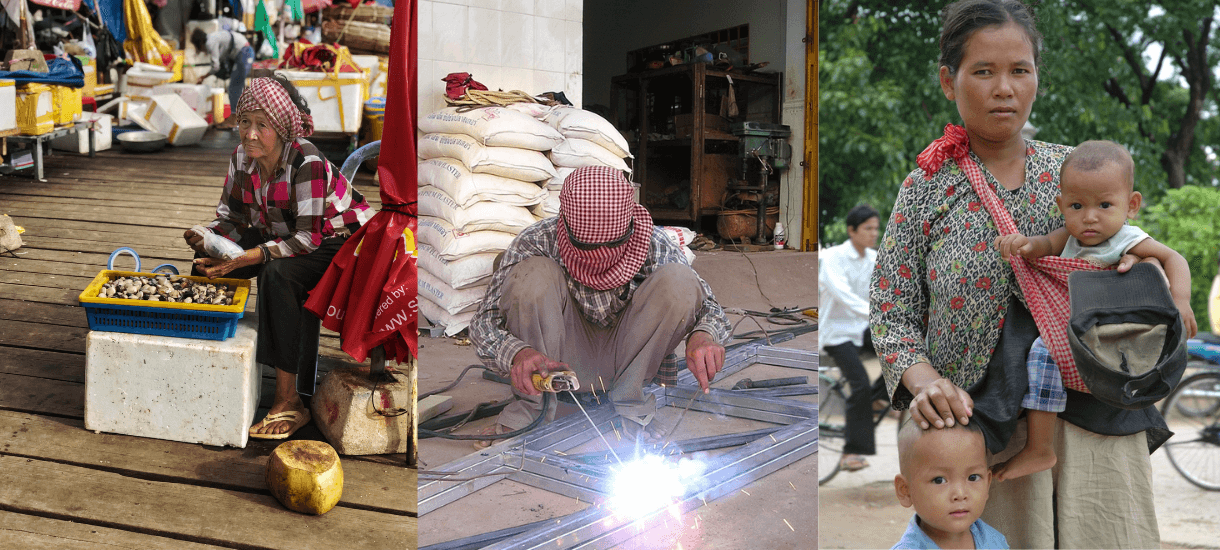
Krama has some non-clothing uses as well. For babies, a krama can function as a hammock.
Also, the ancient Khmer warriors who practiced the martial art of Bokator used krama for some minor protection (i.e. by wrapping it around their fists) and even garrotted their enemies with it.
Summary
You have now had the chance to learn more about Cambodian traditional dress, especially the elegant sampot and the eye-catching krama. If you are ever visiting Cambodia, be sure to take some time to browse traditional fabrics and attire in the markets. You may just find some stunning souvenirs.




